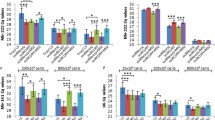Abstract
MicroRNAs (miRNAs) are short noncoding RNA molecules that control the expression of mRNAs associated with various biological processes. Therefore, deregulated miRNAs play important roles in the pathogenesis of diseases. Numerous studies are aimed at discovering biomarkers of diseases or determining miRNA functions by monitoring circulating miRNAs in various biological sources such as plasma and urine. However, the analysis of miRNA in such fluids presents problems related to accuracy and reproducibility because of their low levels in biological fluids. Therefore, better extraction kits and more sensitive detection systems have been developed for improved and reproducible analysis of circulating miRNAs. However, new extraction methods are also needed to improve the yield of miRNAs for their reliable analysis from biological fluids. The combination of yeast transfer RNA (tRNA) and glycogen as carrier molecules and incubation durations were optimized to maximize extraction efficiency. The extraction recovery using a combination of yeast tRNA and glycogen was approximately threefold more than that by using glycogen or yeast tRNA alone. In addition, reproducible and accurate analysis of miRNAs can be carried out after extraction using a combination of yeast tRNA and glycogen without an impact on plasma components.

Steps of miRNA extraction in plasma





Similar content being viewed by others
References
Bartel DP. MicroRNAs: genomics, biogenesis, mechanism, and function. Cell. 2004;116:281–91.
Esteller M. Non-coding RNAs in human disease. Nat Rev Genet. 2011;12:861–74.
Chen X, Ba Y, Ma L, Cai X, Yin Y, Wang K, et al. Characterization of microRNAs in serum: a novel class of biomarkers for diagnosis of cancer and other diseases. Cell Res. 2008;18:997–1006.
Moldovan L, Batte KE, Trgovcich J, Wisler J, Marsh CB, Piper M. Methodological challenges in utilizing miRNAs as circulating biomarkers. J Cell Mol Med. 2014;128:371–90.
Khan N, Cheng J, Pezacki JP, Berezovski MW. Quantitative analysis of microRNA in blood serum with protein-facilitated affinity capillary electrophoresis. Anal Chem. 2011;83:6196–201.
Wegman DW, Ghasemi F, Khorshidi A, Yang BB, Liu SK, Yousef GM, et al. Amplification-free analysis of multiple miRNAs by capillary electrophoresis. Anal Chem. 2015;87:1404–10.
Ban E, Chae DK, Song EJ. Simultaneous detection of multiple microRNAs for expression profiles of microRNAs in lung cancer cell lines by capillary electrophoresis with dual laser-induced fluorescence. J Chromatogr A. 2013;1315:195–9.
Ban E, Chae DK, Song EJ. Enhanced extraction efficiency of miRNA from cells by addition of Triton X-100. Anal Bioanal Chem. 2013;405:7535–9.
Turchinovich A, Weiz L, Langheinz A, Burwinkel B. Characterization of extracellular circulating microRNA. Nucleic Acids Res. 2011;39:7223–33.
McAlexander MA, Phillips MJ, Witwer KW. Comparison of methods for miRNA extraction from plasma and quantitative recovery of RNA from cerebrospinal fluid. Front Genet. 2013;4:2–8.
Hernández-Lucas I, Mavingui P, Finan, Chain P, Martínez-Romero E. Yeast tRNA as carrier in the isolation of microscale RNA for global amplification and expression profiling. BioTechniques. 2002;33:788–96.
Li X, Kong D, Chen H, Liu S, Hu H, Wu T, et al. miR-155 acts as an anti-nflammatory factor in autherosclerosis-associated foam cell formation by repressing calcium-regulated heat stable protein 1. Sci Rep. 2016;6:21789.
Mi S, Zhang J, Zhang W, Huang RS. Circulating microRNAs as biomarkers for inflammatory diseases. Microrna. 2013;2:64–72.
Li Y, Kowdley KV. Genomics Proteomics Bioinformatics. 2012;10:246–53.
Duy J, Koehler JW, Honko AH, Minogue TD. Optimized microRNA purification from TRIzol-treated plasma. BMC Genomics. 2015;16:1–9.
Niu Y, Zhang L, Qiu H, Wu Y, Wang Z, Zai Y, et al. An improved method for detecting circulating microRNAs with S-poly(T) plus real-time PCR. Sci Rep. 2015;5:15100.
Hengen PN. Methods and reagents: carriers for precipitating nucleic acids. Trends Biochem Sci. 1996;21:224–5.
Leidinger P, Keller, Backes AC, Huwer H, Meese E. MicroRNA expression changes after lung cancer resection. RNA Biol. 2012;9:900–10.
Moret I, Sánchez-Izquierdo D, Iborra M, Tortosa L, Navarro-Puche A, Nos P, et al. Assessing an improved protocol for plasma microRNA extraction. PLoS One. 2013;8:e82753.
Cerkovnik P, Perhavec A, Zgajnar J, NovakovicInt S. Optimization of an RNA isolation procedure from plasma samples incubation. J Mol Med. 2007;20:293–300.
Acknowledgements
This work was supported by the National Research Foundation of Korea (NRF) grant funded by the Korea government (MSIP) (2015R1A2A2A04005596 and 2016R1D1A1B03931222) and the intramural grant from the Korea Institute of Science and Technology (2E26990).
Author information
Authors and Affiliations
Corresponding author
Ethics declarations
Conflict of interest
The authors declare that they have no conflict of interest.
Human plasma
Human pooled plasmas collected in K3-EDTA were purchased from Biochemed Service (Winchester, VA, USA).
Rat plasma
Rat plasma samples collected in K3-EDTA from three individual female Sprague Dawley rats were obtained from CHA University (Seongnam, South Korea). The animals were handled in accordance with the guidelines of the Institutional Animal Care and Use Committee (IACUC) of CHA University (IACUC150058), Seongnam, South Korea.
Electronic supplementary material
ESM 1
(PDF 236 kb)
Rights and permissions
About this article
Cite this article
Ban, E., Chae, DK., Yoo, Y.S. et al. An improvement of miRNA extraction efficiency in human plasma. Anal Bioanal Chem 409, 6397–6404 (2017). https://doi.org/10.1007/s00216-017-0580-7
Received:
Revised:
Accepted:
Published:
Issue Date:
DOI: https://doi.org/10.1007/s00216-017-0580-7




